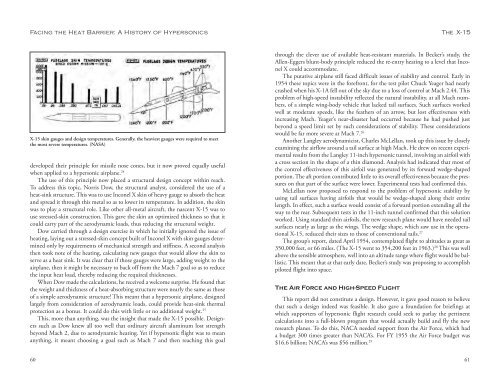Facing the Heat Barrier - NASA's History Office
Facing the Heat Barrier - NASA's History Office
Facing the Heat Barrier - NASA's History Office
You also want an ePaper? Increase the reach of your titles
YUMPU automatically turns print PDFs into web optimized ePapers that Google loves.
<strong>Facing</strong> <strong>the</strong> <strong>Heat</strong> <strong>Barrier</strong>: A <strong>History</strong> of Hypersonics<br />
X-15 skin gauges and design temperatures. Generally, <strong>the</strong> heaviest gauges were required to meet<br />
<strong>the</strong> most severe temperatures. (NASA)<br />
developed <strong>the</strong>ir principle for missile nose cones, but it now proved equally useful<br />
when applied to a hypersonic airplane. 24<br />
The use of this principle now placed a structural design concept within reach.<br />
To address this topic, Norris Dow, <strong>the</strong> structural analyst, considered <strong>the</strong> use of a<br />
heat-sink structure. This was to use Inconel X skin of heavy gauge to absorb <strong>the</strong> heat<br />
and spread it through this metal so as to lower its temperature. In addition, <strong>the</strong> skin<br />
was to play a structural role. Like o<strong>the</strong>r all-metal aircraft, <strong>the</strong> nascent X-15 was to<br />
use stressed-skin construction. This gave <strong>the</strong> skin an optimized thickness so that it<br />
could carry part of <strong>the</strong> aerodynamic loads, thus reducing <strong>the</strong> structural weight.<br />
Dow carried through a design exercise in which he initially ignored <strong>the</strong> issue of<br />
heating, laying out a stressed-skin concept built of Inconel X with skin gauges determined<br />
only by requirements of mechanical strength and stiffness. A second analysis<br />
<strong>the</strong>n took note of <strong>the</strong> heating, calculating new gauges that would allow <strong>the</strong> skin to<br />
serve as a heat sink. It was clear that if those gauges were large, adding weight to <strong>the</strong><br />
airplane, <strong>the</strong>n it might be necessary to back off from <strong>the</strong> Mach 7 goal so as to reduce<br />
<strong>the</strong> input heat load, <strong>the</strong>reby reducing <strong>the</strong> required thicknesses.<br />
When Dow made <strong>the</strong> calculations, he received a welcome surprise. He found that<br />
<strong>the</strong> weight and thickness of a heat-absorbing structure were nearly <strong>the</strong> same as those<br />
of a simple aerodynamic structure! This meant that a hypersonic airplane, designed<br />
largely from consideration of aerodynamic loads, could provide heat-sink <strong>the</strong>rmal<br />
protection as a bonus. It could do this with little or no additional weight. 25<br />
This, more than anything, was <strong>the</strong> insight that made <strong>the</strong> X-15 possible. Designers<br />
such as Dow knew all too well that ordinary aircraft aluminum lost strength<br />
beyond Mach 2, due to aerodynamic heating. Yet if hypersonic flight was to mean<br />
anything, it meant choosing a goal such as Mach 7 and <strong>the</strong>n reaching this goal<br />
60<br />
The X-15<br />
through <strong>the</strong> clever use of available heat-resistant materials. In Becker’s study, <strong>the</strong><br />
Allen-Eggers blunt-body principle reduced <strong>the</strong> re-entry heating to a level that Inconel<br />
X could accommodate.<br />
The putative airplane still faced difficult issues of stability and control. Early in<br />
1954 <strong>the</strong>se topics were in <strong>the</strong> forefront, for <strong>the</strong> test pilot Chuck Yeager had nearly<br />
crashed when his X-1A fell out of <strong>the</strong> sky due to a loss of control at Mach 2.44. This<br />
problem of high-speed instability reflected <strong>the</strong> natural instability, at all Mach numbers,<br />
of a simple wing-body vehicle that lacked tail surfaces. Such surfaces worked<br />
well at moderate speeds, like <strong>the</strong> fea<strong>the</strong>rs of an arrow, but lost effectiveness with<br />
increasing Mach. Yeager’s near-disaster had occurred because he had pushed just<br />
beyond a speed limit set by such considerations of stability. These considerations<br />
would be far more severe at Mach 7. 26<br />
Ano<strong>the</strong>r Langley aerodynamicist, Charles McLellan, took up this issue by closely<br />
examining <strong>the</strong> airflow around a tail surface at high Mach. He drew on recent experimental<br />
results from <strong>the</strong> Langley 11-inch hypersonic tunnel, involving an airfoil with<br />
a cross section in <strong>the</strong> shape of a thin diamond. Analysis had indicated that most of<br />
<strong>the</strong> control effectiveness of this airfoil was generated by its forward wedge-shaped<br />
portion. The aft portion contributed little to its overall effectiveness because <strong>the</strong> pressures<br />
on that part of <strong>the</strong> surface were lower. Experimental tests had confirmed this.<br />
McLellan now proposed to respond to <strong>the</strong> problem of hypersonic stability by<br />
using tail surfaces having airfoils that would be wedge-shaped along <strong>the</strong>ir entire<br />
length. In effect, such a surface would consist of a forward portion extending all <strong>the</strong><br />
way to <strong>the</strong> rear. Subsequent tests in <strong>the</strong> 11-inch tunnel confirmed that this solution<br />
worked. Using standard thin airfoils, <strong>the</strong> new research plane would have needed tail<br />
surfaces nearly as large as <strong>the</strong> wings. The wedge shape, which saw use in <strong>the</strong> operational<br />
X-15, reduced <strong>the</strong>ir sizes to those of conventional tails. 27<br />
The group’s report, dated April 1954, contemplated flight to altitudes as great as<br />
350,000 feet, or 66 miles. (The X-15 went to 354,200 feet in 1963.) 28 This was well<br />
above <strong>the</strong> sensible atmosphere, well into an altitude range where flight would be ballistic.<br />
This meant that at that early date, Becker’s study was proposing to accomplish<br />
piloted flight into space.<br />
The Air Force and High-Speed Flight<br />
This report did not constitute a design. However, it gave good reason to believe<br />
that such a design indeed was feasible. It also gave a foundation for briefings at<br />
which supporters of hypersonic flight research could seek to parlay <strong>the</strong> pertinent<br />
calculations into a full-blown program that would actually build and fly <strong>the</strong> new<br />
research planes. To do this, NACA needed support from <strong>the</strong> Air Force, which had<br />
a budget 300 times greater than NACA’s. For FY 1955 <strong>the</strong> Air Force budget was<br />
$16.6 billion; NACA’s was $56 million. 29<br />
61
















